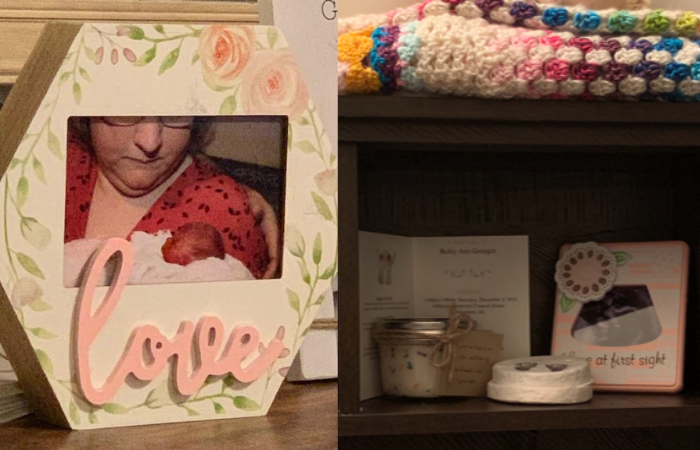
In recognition of the 10th anniversary of the UAB Women & Infants Center (WIC), we asked some women who delivered babies or received care at the WIC to share their experiences. Michelle Granger describes the care and compassion she received as a patient.
I became a patient with the UAB Department of Obstetrics and Gynecology in 2011 after transferring my care from a local private practice group. Since then, I have seen how wonderful all the divisions of the department can be.
When I transferred my care in 2011, I began with the Division of Women’s Reproductive Healthcare for routine gynecological care, and I immediately fell in love with the clinic office suite. Since then, everyone I have interacted with is always friendly and willing to help – from the check-in area to the check-out area and everything in between. When I came in for my new patient appointment, I didn’t have to wait long to see the doctor like I did previously, and I felt that I was a person instead of a number. After that day, I could tell there was something special about this department.
Reproductive Endocrinology & Infertility
In 2014, I was referred to the Division of Reproductive Endocrinology & Infertility to discuss infertility treatments, and in 2018 we decided we were financially able to start treatments . After our third treatment, we succeeded in a confirmed pregnancy, but we never thought our lives would change forever after that day.
After we confirmed the pregnancy, I was transferred back to the Division of Women’s Reproductive Healthcare for obstetric care. The care I received from my doctor was the best ever. She was always willing to answer our questions and made sure that we had all the information we needed before we left the office. We chose to do the blood test to find out the gender of the baby, but after we received the results, it showed something very strange. I was then referred to the Division of Maternal-Fetal Medicine (MFM) for a better understanding of the results, but during this time I was in between the two divisions. My final appointment before I was transferred fully to MFM was when they noticed an increase in my blood pressure, and it was suspected that I could have preeclampsia (high blood pressure during pregnancy).
Maternal-Fetal Medicine
My first appointment with Maternal-Fetal Medicine was to evaluate our baby girl’s bone growth, because she wasn’t growing as much for the time of gestation. But during my second appointment – while they were evaluating her heart – things started to change quickly, and I was admitted that night to the High-Risk Obstetrics Unit.
High-Risk Obstetrics Unit
After I was admitted, many things were being discussed, and a lot of decisions had to be made. After all the test results came back, it was concluded that I did in fact have early-onset preeclampsia. This was a lot to take in, considering that I was only finishing my 22nd week, and she was only measured to be between 16-18 weeks. My husband and I chose to keep the pregnancy as long as we could, hoping for a happy ending, but with that decision we chose to stay there for the remainder of the pregnancy, since my blood pressure was so high. I met some fantastic people there. The faculty, nurses, and staff were all super nice and helpful, especially on the occasions when my emotions were taking a toll. After two weeks in the unit, we found out that there was no heartbeat and that we lost our baby. We were then transferred to the Labor and Delivery Unit to begin the delivery process.
Labor and Delivery Unit
While in Labor and Delivery, more decisions were being made, and we started the delivery process. This went on for most of the night and into the early morning hours. The hardest part of the entire pregnancy was delivering a stillborn child, but the nursing staff was very compassionate and helped us along the way. After I delivered, I was then transferred to the Gynecology Unit, so I wouldn’t have to be around the babies crying in the Mother Baby Unit, which showed even more compassion.
I was only in the Gynecology Unit overnight to complete my 24-hour magnesium drip, and during that time, my nurses gave me the best care. The compassion was still there when I became emotional, and they helped me along the way. When I was released, they made sure everything was taken care of before I left. That day was definitely the toughest of all, because I had to leave my baby girl knowing that I was never going to have those first events with her.
Reproductive Endocrinology & Infertility
A year later, in November 2019, I returned to Reproductive Endocrinology & Infertility, and we are planning how to proceed with infertility treatments again. Even though the last pregnancy was unsuccessful, we are not giving up on trying to have a child. We know there may be some roadblocks ahead during this process, but we are going to take things each day as we go through the process.
I never thought I would be involved with all these divisions over nine years, but I am looking forward to the many years to come. Losing a pregnancy is a very difficult thing to go through, but knowing that I’m a patient of one of the best hospitals in the U.S. helps me know that I’m always going receive the best care.
Click here to learn more about the UAB Women & Infants Center.
